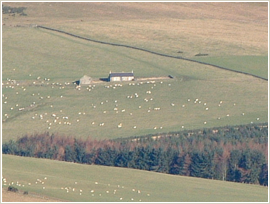Populations in Forfar- and Kincardine-shire Parishes
Although most of this information is available in the various Statistical Accounts of Scotland, I thought it might be helpful to extract the population details for relevant parishes in Forfarshire (Angus) and Kincardineshire and put them into one comparative table. For good measure I have also added more recent data from 1921 - the latest available.
The early figures reflect the growth of towns at the expense of the countryside, with people turning away from the subsistence living of crofting to the more lucrative occupation of weaving – first at home and then in the factories that sprang up in towns. It is apparent that this trend was continued in 1921, although by this time the linen industry had long declined and people had moved to even bigger cities such as Glasgow.
Parish Population
1755 1790s 1831 1841 1921
Arbroath 2098 4676 6943 21385
Banchory-Ternan 1736 1340 1972 2240 3710
Cortachy & Clova 1233 1020 912 867 577
Inverbervie 655 1200 1135 2153
Kirriemuir 3409 4358 6425 5074
Lethnot & Navar 635 505 404 400 169
Marykirk 1285 1481 2032 2389 1285
Menmuir 743 900 871 731 644
St Cyrus 1271 1763 1598 1600 1306
St Vigeans 1592 3336 8780 21385
Tannadice 1491 1491 1560 918
The actual dates for the returns in the 1790s were: Lethnot & Navar, 1790-91; Marykirk, 1790-95; Arbroath, Banchory-Ternan, and Menmuir, 1791-92; Inverbervie, Kirriemuir, St Cyrus and St Vigeans, 1791-93; and Cortachy & Clova, 1792-93. There was no return for Tannadice between 1790-1797.
Part of the burgh of Arbroath lay in the parish of St Vigeans, so the figures do not reflect the total population of the burgh; in fact, the 1841 figure for St Vigeans includes 6037 within the burgh of Arbroath, in the Inverbrothock and Ladyloan districts.
For the years 1891-1921, the data is for the united civil parish of Arbroath & St Vigeans.
----------
However, I have just come across another document published in 1823 called Enumeration of the Inhabitants of Scotland taken from the government abstracts from 1801, 1811 and 1821. The figures throw additional light on the population of the parishes because they give the number of houses, families, those employed in agriculture or manufacturing trades, males and females etc.
Thus in 1821 for the Shire of Forfar, we can learn that in Arbroath, otherwise Aberbrothock, Burgh and Parish, there were 726 inhabited houses occupied by 1494 families – thus an average of about two families per house, though we do not know how many members there were in each family. However, since there were 5817 people in the burgh and parish (2502 males and 3315 females) that would give an average of about four people per family (though we know that some families comprised a single member or a couple, while some families had a lot of children.) There were also three houses being built (at least that is what I assume the heading Building (under Houses) means and five houses being uninhabited. In the burgh and parish, there were 31 families chiefly employed in agriculture; 1155 families chiefly employed in trade, manufacture and handicraft; and 308 families not chiefly employed in these two categories (presumably such families were those of ministers, retired people, soldiers, general labourers, paupers etc.) There is a note to the effect that the increase of the sail cloth and linen manufactories accounts for the increase of the population at Arbroath. Including the town part of the Parish of St. Vigeans, Arbroath contains 8972 inhabitants.
In 1821 the statistics for the Parish of St. Vigeans were 976 houses inhabited by 1347 families with seven houses being built and 22 lying empty. A total of 272 families were chiefly employed in agriculture, while 1035 were chiefly employed in trade, manufacturers or handicraft, with just 43 families employed in other occupations. The parish comprised a total of 5585 people, 2650 being male and 2933 being female. There is a note saying that St. Vigeans is adjacent to the Town of Arbroath, and partakes in the prosperity of the sail cloth and linen manufactures.
Few of my definitely identified Raitt ancestors (and those to whom they were married) worked in agriculture – most seem to have been weavers, like nearly everyone else in Arbroath/St. Vigeans, though some were merchant seamen and others were craftsmen. However, we do know that Raitt families were farming around Boysack and Cotton in St. Vigeans parish – though I have yet to prove the family link. The greater number of women over men could be a result of young girls from outlying districts coming to the towns to work in the linen industry (as opposed to being just a serving wench) , while men probably stayed on as agricultural labourers. Once in the towns though and working as weavers, then children, including the boys, would have been engaged in the cloth industry.
The earliest people on my maternal side came from Lethnot & Navar in Forfarshire. In 1821, there were 99 houses and 99 families, one house being built and 15 houses uninhabited. 58 of the 99 families were employed in agriculture mainly, with 13 in trade, manufactures and handicraft, and a hefty 28 families employed in neither of these two (what wee they doing then?) Of the total population in the parish in 1821, 283 were male and 255 were female. A note states that one man in the parish was aged upwards of 100 years.
Monday, 21 May 2012

